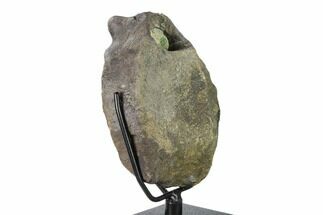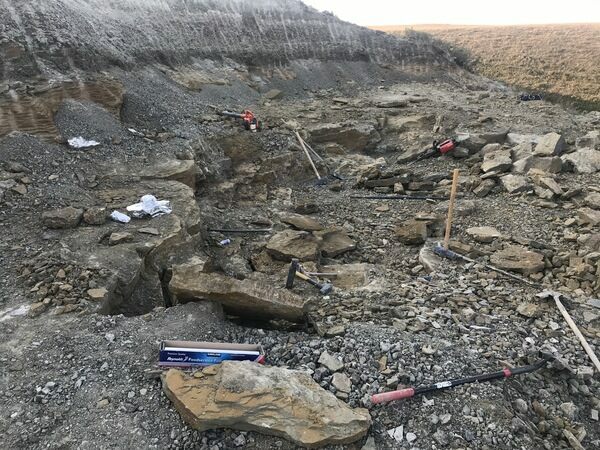This Specimen has been sold.
18" Hadrosaur (Hypacrosaur) Radius and Vertebra in Stone - Montana
This is a breathtaking specimen that features a caudal vertebra and radius (arm bone) still sitting within the rock they were found in, a presentation that is quite uncommon. Both are from Hypacrosaurus, a hadrosaur of the Two Medicine Formation of Montana, though it's possible they came from two separate hadrosaurs. This is a natural association and the bones have not been repositioned.
The radius is almost completely exposed from the rock, with the proximal end still partially embedded. There are multiple repaired cracks through the diaphysis, with some significant gap fill restoration within one of the cracks where the bone was fragmented beyond recovery. The distal end, while weathered, did not require any crack repair or restoration.
Just over half of the vertebra has been exposed from the rock. The cortical bone has weathered away, however it hasn't undergone any repair or restoration. A small section of rock adjacent to the vertebra has been glued back in place. The base of the rock has been cut flat, facilitating aesthetic presentation of this incredible hadrosaur bone association.
Measurments:
Radius - 17.9" long
Vertebra - 2.25" wide
Rock (not including bones) - 12.7 x 6.8 x 6"
The radius is almost completely exposed from the rock, with the proximal end still partially embedded. There are multiple repaired cracks through the diaphysis, with some significant gap fill restoration within one of the cracks where the bone was fragmented beyond recovery. The distal end, while weathered, did not require any crack repair or restoration.
Just over half of the vertebra has been exposed from the rock. The cortical bone has weathered away, however it hasn't undergone any repair or restoration. A small section of rock adjacent to the vertebra has been glued back in place. The base of the rock has been cut flat, facilitating aesthetic presentation of this incredible hadrosaur bone association.
Measurments:
Radius - 17.9" long
Vertebra - 2.25" wide
Rock (not including bones) - 12.7 x 6.8 x 6"
About Hypacrosaurus
Hypacrosaurus is a very large, Lambeosaurini Hadrsosaur that would have been almost as large as the Tyrannosaurs that it lived alongside. Like Corythosaurus, it had a tall, hollow, rounded crest, although not as large and straight. It is known from the remains of two species that spanned 75 to 67 million years ago in the Late Cretaceous of Alberta, Canada, and Montana, United States, and is the latest hollow-crested duckbill known from good remains in North America. It is estimated to have been around 9.1 meters (30 feet) long and to have weighed up to 4-5 tons.
Hypacrosaurus is a very large, Lambeosaurini Hadrsosaur that would have been almost as large as the Tyrannosaurs that it lived alongside. Like Corythosaurus, it had a tall, hollow, rounded crest, although not as large and straight. It is known from the remains of two species that spanned 75 to 67 million years ago in the Late Cretaceous of Alberta, Canada, and Montana, United States, and is the latest hollow-crested duckbill known from good remains in North America. It is estimated to have been around 9.1 meters (30 feet) long and to have weighed up to 4-5 tons.
About The Two Medicine Formation
The Two Medicine Formation is a geographical formation in Central Montana and Southern Alberta, Canada. The formation is predominantly sandstone laid down by rivers and deltas during the Campanian Age of the Cretaceous, about 80-75 million years ago. Approximately two thousand feet thick on the western edge, it lies on top of the Virgelle Sandstone formation and under the Bearpaw Shale. It is located between the Front Range of the Rocky Mountains and the Sweetgrass Arch, a tectonic fold feature 40-90 miles east of the Front Range.
The Two Medicine is the same age as the Judith River Formation found further east. It was laid down further inland from the Western Interior Seaway, while the Judith River Formation was deposited along the coast. The Two Medicine contains much of the same dinosaur fauna, but fewer reptiles, amphibians, and aquatic fossils.
The Two Medicine Formation is a geographical formation in Central Montana and Southern Alberta, Canada. The formation is predominantly sandstone laid down by rivers and deltas during the Campanian Age of the Cretaceous, about 80-75 million years ago. Approximately two thousand feet thick on the western edge, it lies on top of the Virgelle Sandstone formation and under the Bearpaw Shale. It is located between the Front Range of the Rocky Mountains and the Sweetgrass Arch, a tectonic fold feature 40-90 miles east of the Front Range.
The Two Medicine is the same age as the Judith River Formation found further east. It was laid down further inland from the Western Interior Seaway, while the Judith River Formation was deposited along the coast. The Two Medicine contains much of the same dinosaur fauna, but fewer reptiles, amphibians, and aquatic fossils.
SPECIES
Hypacrosaurus sp.
LOCATION
Pondera County, Montana
FORMATION
Two Medicine Formation
SIZE
Rock: 12.7 x 6.8", Radius: 18" long, Vertebra: 2.25" wide
CATEGORY
SUB CATEGORY
ITEM
#196687
We guarantee the authenticity of all of our specimens.
 Reviews
Reviews




















